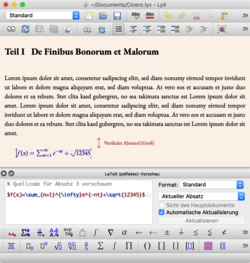LyX
| LyX
|
|
|---|---|

|
|
 Lorem ipsum with LyX 2.3.2 |
|
| Basic data
|
|
| developer | LyX team |
| Current version | 2.3.4 (January 31, 2020) |
| operating system | Linux , macOS , Windows , Unix |
| programming language | C ++ |
| category | DTP |
| License | GPL |
| German speaking | Yes |
| lyx.org | |
LyX is a graphical front-end that uses the LaTeX typesetting system for output . It combines a clear graphical user interface with high-quality typographical output and is therefore similar to a word processing system .
Special features of LyX
At first glance, the user interface looks similar to that of the graphic word processing systems from LibreOffice or Microsoft Office . However, the concept is vastly different.
Separation of text entry and typesetting
With LyX, the document is only formatted when it is output. First the text is recorded. The user simply tells the system which function, such as heading , title , normal text or formula set, the relevant text in the formatted document should take on. The LaTeX macro language of the TeX typesetting program is used for output . That is why LyX guarantees high quality typesetting . Further strengths lie in the representation of mathematical formulas and the management of footnotes and indexes .
Representation when editing
When editing the document, the view is optimized for display on the screen. Similar to HTML , the length of the lines is based on the width of the window and there is no page break on the screen. LyX follows a WYSIWYM strategy for structural elements of the document .
Structural elements such as headings or lists are formatted so that they are recognizable as such, but not necessarily as they appear in the printed document. For example, a font that has been optimized for the screen can be selected for the headings without affecting the printed result.
Input via keyboard or mouse
To capture the document, most elements have both graphic access via the mouse and via the keyboard. In particular, many commands of the LaTeX syntax are recognized and automatically converted into a suitable graphic representation.
Unrecognized commands are passed on unchanged to LaTeX when they are output. In this way it is possible to use all the possibilities of LaTeX. These commands are displayed in red in the editing window. However, this display runs counter to the project goal of not showing any commands in the editing window. From this, the term Evil Red Text , angry red text , abbreviated ERT , developed within the project, half jokingly .
development
LyX was developed in 1995 by the then computer science student Matthias Ettrich as part of his study project with the GUI toolkit Motif . When, after completing his studies, he looked for colleagues on the Internet in order to further develop LyX together, he found that only a few had experience or access to Motif. So he was looking for a new, free GUI toolkit. Ultimately, the choice fell on the XForms toolkit . In later years the GUI Independence Framework was introduced in order to ensure that other GUI toolkits ( Qt , Gtk ) can be used in addition to XForms . In current versions only the GUI toolkit Qt is supported.
literature
- Jan Peter Gehrke, Steven Stannard: LyX - a quick introduction. Creating TeX documents made easy . De Gruyter Oldenbourg, Berlin 2016, ISBN 978-3-11-044144-4 .
- David Kastrup: LaTeX and WYSIWYG? preview-latex under Emacs and other approaches . In: The TeXnian Comedy . No. 4/2002 . German-speaking user association TeX, 2002, ISSN 1434-5897 , p. 10–26 ( dante.de [PDF] English edition, preprint ).
Web links
- LyX project page
- eComStation and OS / 2 porting (English)
- The LyX user manual (PDF) - German-language documentation for the program
Individual evidence
- ↑ What is Evil Red Text? , Explanation of the term ERT in the LyX Wiki.
